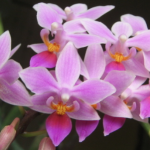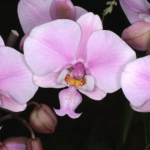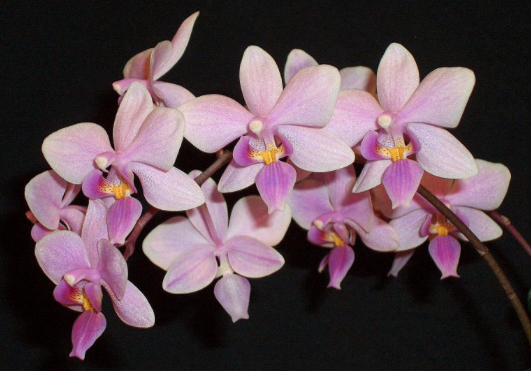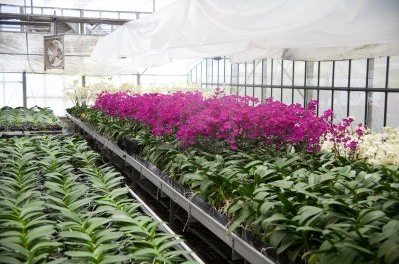+ Spanish
There are tons of varieties in this genus. Besides the species that grow in nature, there are hundreds of hybrids made by men.
natural hybrids:
Also, there are some hybrids that are created naturally, thanks to the confusion of some insect that deposits the polen from one specie into another; these hybrids are identified with the letter x before their last names; for example, Phalaenopsis x veitchiana, which is the result of the cross between Phalaenopsis equestris and Phalaenopsis schilleriana.
Phalaenopsis equestris
Phalaenopsis schilleriana
Phalaenopsis x veitchiana
artificial hybrids:
Now, when we talk about the hybrids that are made by the hand of men, some of these are mass produced (let’s remember that Phals represent 75% of the sales in the orchid market). It’s usual to find a Phal “NOID”, which means that it’s a plant without identification; we know it’s a Phalaenopsis hybrid, but we don’t know from which species or even from which hybrids it comes from.
Some of these mass produced hybrids through lab micropropagation have only a commercial purpose = money. Their genetic load is so week, that they are often disposable and after one flowering period, they will die. Let’s think of it this way: if you cross a thoroughbred horse with another thoroughbred horse, the genetic load will maintain it’s strength. If we cross a thoroughbred with a hobbyhorse, the offspring will be genetically poorer. If we continue crossing this genetically poorer offsprings between them, after a few generations, these horsies will continue to lose genetic load and their offsprings will be weaker and weaker. Furthermore, let’s think that we are also overusing growth stimulators and hormones to grow them faster than they’d normally grow… then we’ll have full-grown horses in size, but poorly developed ones. The same thing happens with these orchid hybrids! And that’s the sole reason why sometimes, no matter what we do to preserve them, this plants are very weak and much more susceptible to disease and they will die.
This method of propagation is the reason why we find flowering Phals throughout the year in big box stores and such. These plants have been artificially induced into flowering in the nurseries, jus before they are shipped to the stores. The main Countries that produce Phals like this are: Netherlands, Malaysia, Taiwan and Thailand.
However, not all hybrids are produced like this! Some crosses do have a name and last name, are properly classified and can even win awards in orchid shows under the category “hybdrids” (they don’t compete with species). This type of hybrids are produced with a comercial purpose also, but mainly for the love orchids and their preservation and with great pride from their creators. For example: Phalaenopsis Baldan’s Kaleidoscope, that is a cross between Phal. hausermann’s candy y Phal. daryl lockhart.
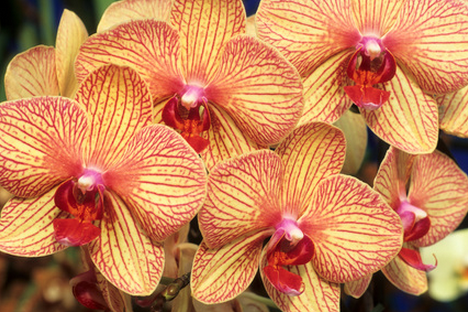
The important thing here is to know where we are getting our plants from! From a serious nursery, a big box store… and to know what to expect from these plants to avoid unnecessary frustrations!!
intergeneric hybrids:
Unlike other plant groups, artificial hybridization of orchids is a relatively easy procedure. Many orchids don’t have internal barriers that block hybridization between species, or even between two different genus. When the cross is between genus, we are talking about intergeneric hybrids.
This technique it’s an instrument of great value that has lead to the production of a huge number of orchid hybrids. Geneticists have been able to achieve hybrids from 5 different genus, e.g. Rothara (Brassavola x Cattleya x Epidendrum x Laelia x Sophronitis); and even form six genus: Brillandeara (Aspasia x Brassia x Cochlioda x Miltonia x Odontoglossum x Oncidium). Or simpler ones, between only 2 genus like Vandaenopsis (Phalaenopsis and Vanda).
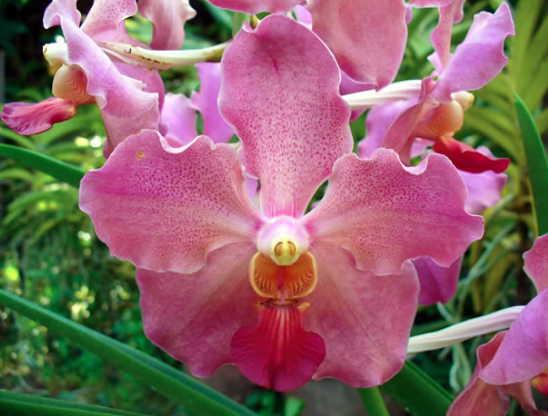
Vandaenopsis David Marshall


